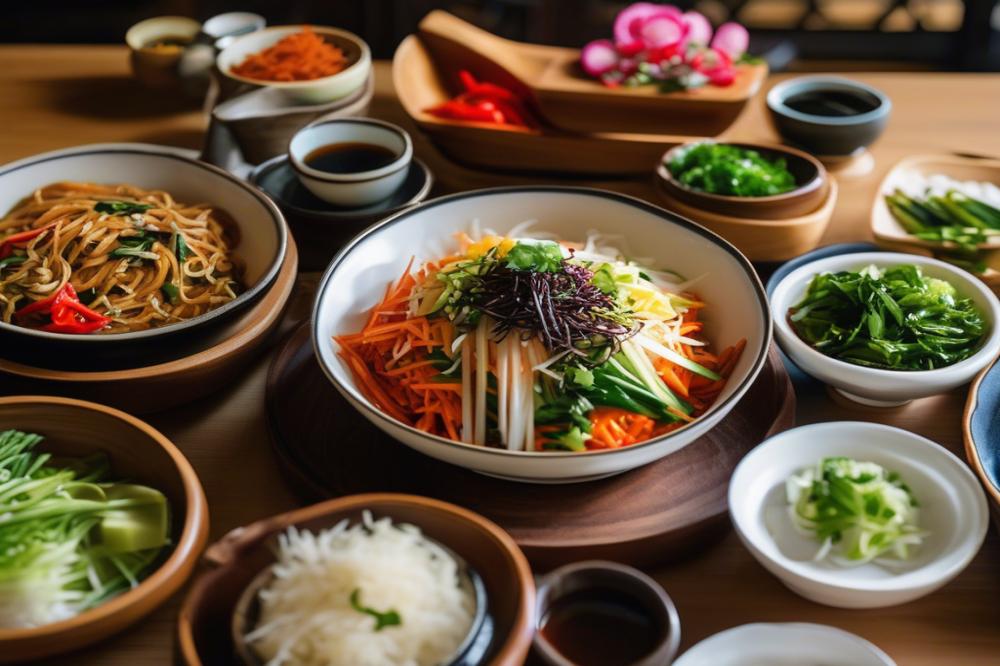Introduction
Banchan refers to small plates of food served with Korean meals. These side dishes play a vital role in traditional Korean dining. They add flavor, variety, and color to the table. Vegetables often star in these dishes, offering both taste and nutritional balance. Fermentation is a popular technique in many Banchan recipes, most notably in kimchi, a beloved staple.
The importance of these small plates goes beyond just food. They invite sharing and conversation among diners. In Korea, meals are often enjoyed family-style, with dishes placed collectively on the table. This way of eating encourages connection and interaction. Each bite brings a new taste, making the dining experience rich and enjoyable.
Our article will guide you through various recipes for Korean side dishes. You will discover quick and healthy options that are perfect for any meal. From easy-to-make vegetable banchan to the intricate techniques used in classic dishes, we aim to share knowledge and inspire. Read on to explore the delightful world of banchan and learn how to enhance your own dining experiences.
What is Banchan?
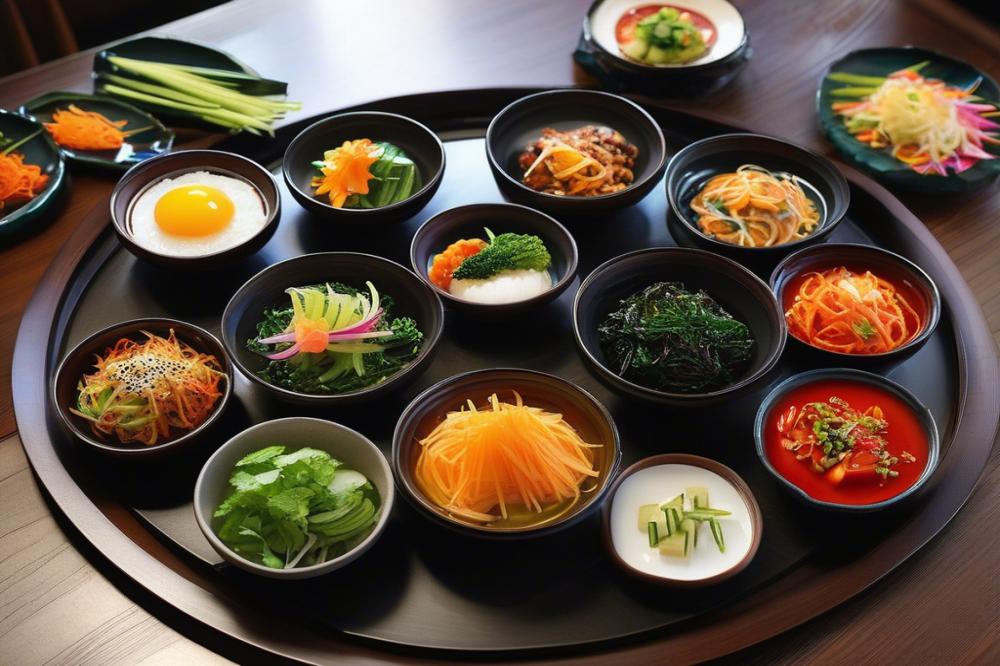
Banchan refers to the various small side dishes served along with a main meal in Korean cuisine. This practice is a significant part of dining in Korea, creating a communal experience. Each dish contributes to the overall flavor and nutrition of the meal. It’s more than just food; it’s a reflection of Korean culture and hospitality.
Types of Banchan
Various kinds of banchan exist, each with its own preparation method. Fermented dishes are especially popular. Kimchi, a staple in Korean households, is a prime example. Made from vegetables, usually napa cabbage, it undergoes fermentation, resulting in a tangy, spicy flavor. Other vegetable-based sides, such as pickled radish or seasoned spinach, offer freshness and texture. Quick preparations also play a role; stir-fried or sautéed vegetables can be made in no time. Whether they take hours or just a few minutes, these recipes each have their own charm.
The Role of Banchan
Banchan enhances the main course in several ways. Each small plate introduces varied flavors and textures. They provide balance, making the meal more satisfying. Nutrition is also a key factor; these dishes often contain vegetables packed with essential vitamins and minerals. Eating a variety of banchan can encourage healthier dining habits. Sharing these dishes brings family and friends closer during mealtime, highlighting the value of togetherness in Korean culture.
Essential Ingredients for Banchan
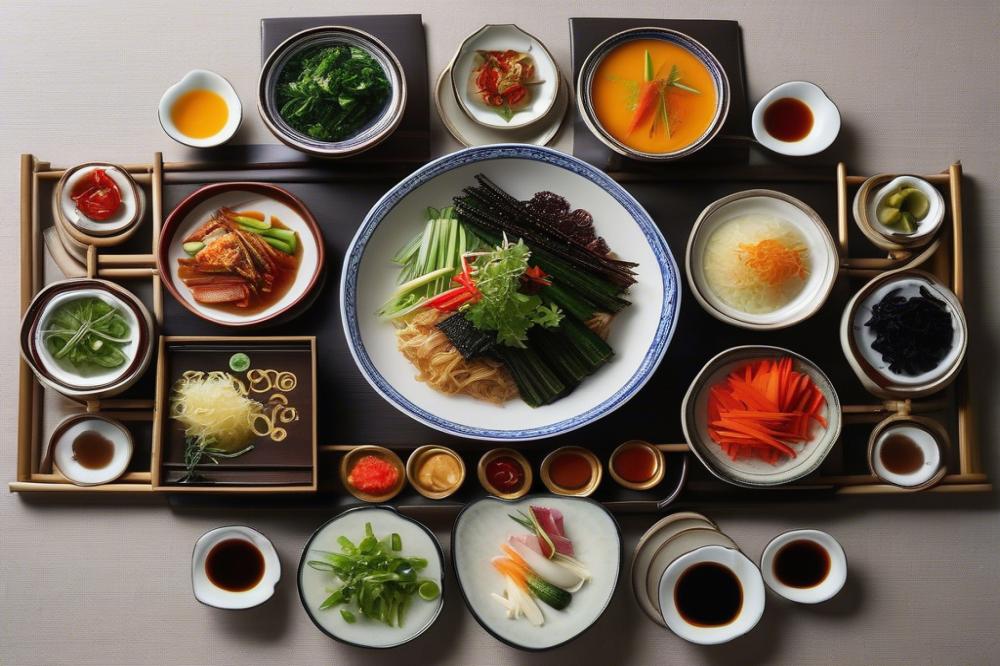
Making delicious small plates starts with knowing the right ingredients. Many recipes highlight common components that bring authentic Korean flavors to life. Gochujang, a fermented chili paste, adds sweetness and heat to dishes. Its deep, rich flavor can transform simple vegetables into something exciting. Doenjang, a fermented soybean paste, is another staple. It provides a savory umami taste that acts as a wonderful base for many side dishes.
Using sesame oil adds a nutty aroma to the mix. This oil is often drizzled over finished dishes for added richness. Each of these ingredients helps to create the vibrant flavors that characterize these traditional Korean accompaniments.
Key vegetables play an important role as well. Napa cabbage is essential for making kimchi, a famous fermented dish enjoyed across the globe. Radishes, with their crunchy texture, can be pickled or used in salads. Cucumbers are often sliced fresh for a quick, healthy addition to meals. These vegetables not only provide crunch but also bring color and freshness to each plate.
Focus on balance while preparing these side dishes. Combining flavors such as sweet, spicy, and savory can enhance the overall dining experience. The variety in textures and tastes makes each meal unique. No complicated techniques are required; many recipes can be made in under thirty minutes. Simple, fresh ingredients highlight the essence of the traditional Korean dining experience.
Classic Banchan Recipes
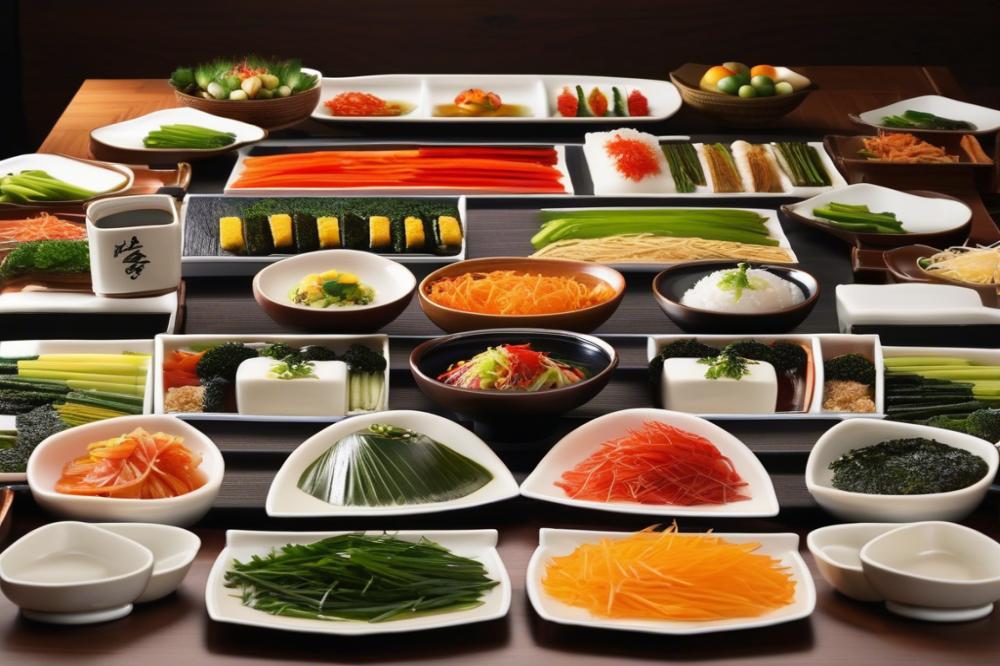
Recipe 1: Kimchi
This traditional Korean dish is famous for its unique flavor and health benefits. Made from fermented vegetables, it often serves as a staple in many meals.
Ingredients List:
- 2 pounds Napa cabbage
- 1/2 cup coarse sea salt
- 4 cups water
- 1 tablespoon grated ginger
- 2 cloves garlic, minced
- 2 tablespoons fish sauce
- 3 tablespoons Korean red pepper flakes (gochugaru)
- 1 teaspoon sugar
- 2 green onions, chopped
Cooking Instructions:
- Chop the Napa cabbage into quarters and remove the core.
- Combine water and salt in a large bowl. Soak the cabbage in the saltwater for about 2 hours, turning occasionally.
- Drain the cabbage and rinse it thoroughly under cold water.
- In a separate bowl, mix garlic, ginger, fish sauce, gochugaru, and sugar.
- Add the drained cabbage and green onions to the seasoning mix. Massage the mixture into the cabbage until well-coated.
- Pack the kimchi tightly into a jar or container, leaving space at the top for fermentation.
- Seal the container and leave it at room temperature for 1-2 days. After fermentation, store it in the refrigerator.
Nutritional Information for each ingredient:
- Napa cabbage (2 lbs): ~60 calories, low in fat, high in vitamin K.
- Coarse sea salt (1/2 cup): negligible calories, important for preservation.
- Water (4 cups): no calories, essential for hydration.
- Ginger (1 tbsp): ~5 calories, contains anti-inflammatory compounds.
- Garlic (2 cloves): ~9 calories, supports immune health.
- Fish sauce (2 tbsp): ~30 calories, rich in umami flavor.
- Korean red pepper flakes (3 tbsp): ~15 calories, increases metabolism.
- Sugar (1 tsp): ~16 calories, adds a touch of sweetness.
- Green onions (2 stalks): ~10 calories, packed with vitamins.
Recipe 2: Pickled Radish (Danmuji)
This quick and delightful side dish adds a refreshing crunch to any meal. Pickled radish is a common sight in traditional Korean dining.
Ingredients List:
- 2 cups daikon radish, julienned
- 1 cup water
- 1/2 cup rice vinegar
- 1/3 cup sugar
- 1 teaspoon salt
- 1 teaspoon turmeric (optional)
Cooking Instructions:
- Mix water, rice vinegar, sugar, salt, and turmeric in a bowl until combined.
- Place the julienned radish into a jar.
- Pour the pickling liquid over the radish, ensuring it is fully submerged.
- Seal the jar and refrigerate for at least 24 hours before serving.
Nutritional Information for each ingredient:
- Daikon radish (2 cups): ~30 calories, high in fiber and vitamins.
- Water (1 cup): no calories, important for overall health.
- Rice vinegar (1/2 cup): ~15 calories, low in calories and flavorful.
- Sugar (1/3 cup): ~100 calories, adds sweetness to the dish.
- Salt (1 tsp): negligible calories, enhances flavor.
- Turmeric (1 tsp): ~9 calories, known for its anti-inflammatory properties.
Recipe 3: Seasoned Spinach (Sigeumchi namul)
This healthy vegetable dish packs flavor while providing valuable nutrients. Spinach is versatile and can be enjoyed either warm or cold.
Ingredients List:
- 1 pound fresh spinach
- 1 tablespoon sesame oil
- 1 tablespoon soy sauce
- 1 teaspoon minced garlic
- 1 teaspoon sesame seeds
- Salt to taste
Cooking Instructions:
- Bring a pot of water to a boil. Blanch the spinach for about 30 seconds.
- Drain and cool the spinach in cold water to stop the cooking process.
- Squeeze the spinach to remove excess water and chop finely.
- In a bowl, mix together sesame oil, soy sauce, garlic, and salt.
- Add the spinach to the mixture and toss to coat evenly.
- Sprinkle with sesame seeds before serving.
Nutritional Information for each ingredient:
- Fresh spinach (1 lb): ~90 calories, rich in iron and vitamins A and C.
- Sesame oil (1 tbsp): ~120 calories, provides healthy fats.
- Soy sauce (1 tbsp): ~10 calories, adds umami flavor.
- Garlic (1 tsp): ~5 calories, boosts immune function.
- Sesame seeds (1 tsp): ~5 calories, a good source of fiber.
Making Banchan: Tips and Techniques
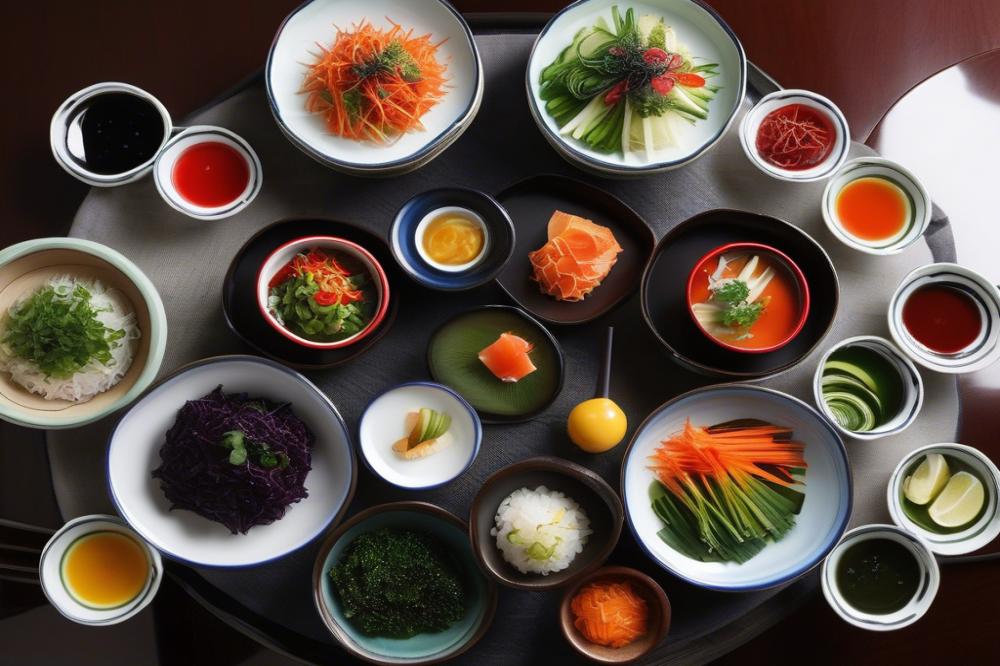
Overview of Preparation Methods
In Korean cuisine, various preparation methods bring out unique flavors in dishes. Fermentation is one of the most traditional techniques. It transforms ingredients over time and gives life to staples like kimchi. Quick pickling offers a faster alternative, brightening vegetables with tartness. This method is ideal for busy cooks who crave fresh tastes. Another approach is blanching, which gently cooks vegetables while maintaining their vibrant colors and crunch. This technique helps in preserving nutrients while enhancing flavors.
Importance of Seasoning and Balancing Flavors
Flavor plays a vital role in any recipe. Enhancing banchan involves a careful balance of salty, sweet, and sour notes. Using ingredients like garlic, ginger, and soy sauce adds depth. When preparing these small plates, it’s essential to taste as you go. Adjusting seasoning ensures that each dish sings with harmony. A well-seasoned side will elevate any meal, complementing the main dishes beautifully.
Tips for Presentation and Serving
Presentation can elevate the dining experience. Colorful vegetables should be arranged thoughtfully on a plate. Small bowls or dishes for each item create an inviting spread. Using garnishes like sesame seeds or sliced scallions adds visual appeal. Serving banchan alongside rice or main courses invites sharing and conversation. Keep portions modest; these should be shared and enjoyed together. Proper serving also exudes a sense of hospitality, embodying the spirit of Korean dining.
Final Thoughts on Banchan
Banchan plays a significant role in Korean cuisine. These delightful side dishes add flavor, texture, and color to every meal. They not only complement the main course but also reflect the rich culinary traditions of Korea. Dining is an experience that goes beyond mere sustenance. It is a way to enjoy the company of friends and family while sharing delicious meals.
Trying your hand at making these dishes at home can lead to healthier eating habits. Many recipes are simple and use fresh, seasonal ingredients. Preparing them yourself allows you to control what goes into each dish, making it a wholesome choice for you and your loved ones. Gathering in the kitchen to create these side dishes can also foster connection and creativity.
Exploring the variety of Korean recipes offers endless possibilities. From spicy kimchi to sweet pickled radish, there is a dish for every palate. Each recipe tells a story, representing flavors that have been passed down through generations. The more you experiment, the more you will discover the depth of flavors found in these traditional side dishes.
In conclusion, embracing the world of banchan can elevate your meals and broaden your culinary horizons. Every bite is an invitation to enjoy Korean culture and its vibrant food scene. So roll up your sleeves and dive in. You may just fall in love with making these delicious side dishes!

